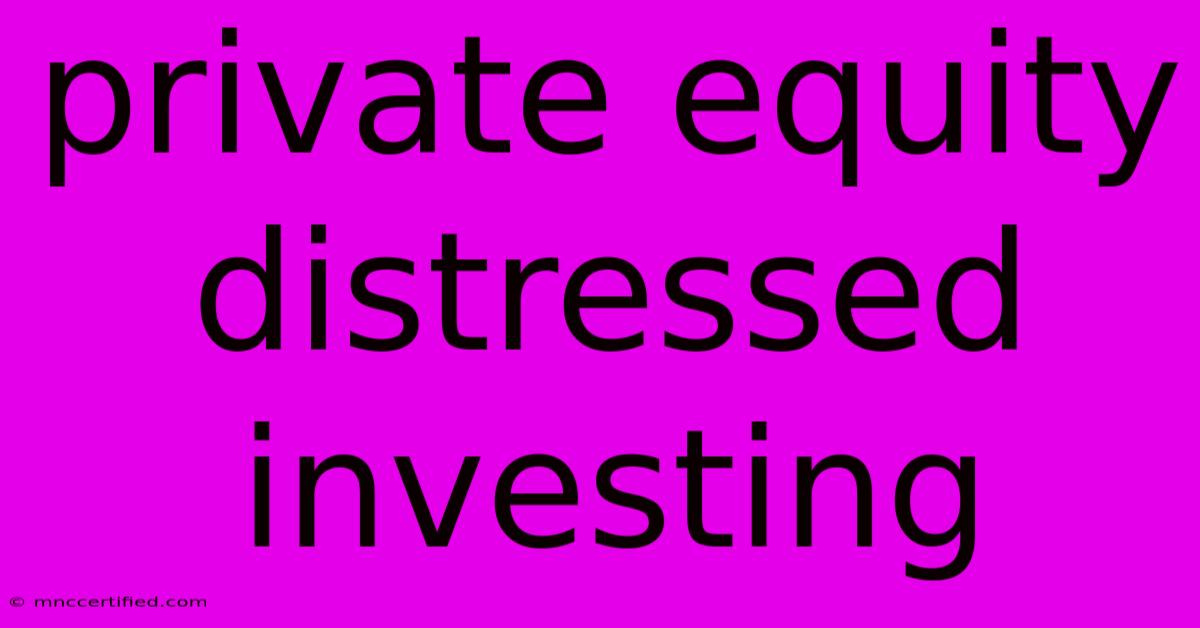Private Equity Distressed Investing

Table of Contents
Navigating the Storm: A Guide to Private Equity Distressed Investing
Private equity investing is known for its high-risk, high-reward potential. But within this realm lies a niche strategy that can be particularly lucrative, albeit challenging: distressed investing. This approach focuses on acquiring companies or assets in financial distress, seeking to revitalize them and generate substantial returns. This article will delve into the intricacies of distressed investing, exploring its advantages, risks, and key considerations for success.
What is Distressed Investing?
Distressed investing involves acquiring businesses or assets that are facing significant financial difficulties, such as:
- Declining revenues and profits
- High debt levels
- Operational inefficiencies
- Legal or regulatory issues
These companies often find themselves in dire straits, facing potential bankruptcy or liquidation. Distressed investors, however, see this as an opportunity. By acquiring these companies at a discounted price, they aim to turn around the business, improve its financial health, and ultimately sell it at a profit.
Advantages of Distressed Investing
While risky, distressed investing presents several potential advantages:
- Significant Upside Potential: The potential for high returns is significant due to the deep discounts often available for distressed assets.
- Control and Influence: Distressed investors often gain a significant amount of control over the acquired company, allowing them to implement their own restructuring and turnaround strategies.
- Market Inefficiencies: Distressed markets are often characterized by inefficiencies, providing opportunities for astute investors to capitalize on undervalued assets.
Risks of Distressed Investing
Distressed investing is not for the faint of heart. Several risks are associated with this strategy:
- Complexity and Time Commitment: Restructuring and turnaround efforts require significant time, expertise, and resources.
- Operational Challenges: Distressed companies often face significant operational challenges, including poor management, outdated technology, and weak customer relationships.
- Lack of Market Liquidity: Distressed assets may be difficult to sell quickly, making it challenging to realize gains.
- Regulatory and Legal Issues: Distressed companies are often subject to regulatory scrutiny and legal challenges.
Key Considerations for Successful Distressed Investing
Success in distressed investing hinges on a careful understanding of the market, the company, and the risks involved. Key considerations include:
- Thorough Due Diligence: Conducting a comprehensive analysis of the company's financials, operations, and legal situation is crucial.
- Strong Restructuring Expertise: Distressed investors need expertise in restructuring, turnaround management, and financial engineering.
- Strong Financial Resources: Turning around a distressed company requires significant financial resources.
- Strategic Exit Plan: Having a well-defined exit strategy, including a plan for selling or restructuring the company, is essential.
The Role of Private Equity in Distressed Investing
Private equity firms play a significant role in distressed investing. They possess the resources, expertise, and network to effectively acquire, restructure, and exit distressed companies. Their involvement brings:
- Financial Resources: Private equity firms provide capital for acquisitions, debt restructuring, and operational improvements.
- Operational Expertise: Their experience in various industries and turnaround management provides valuable insights.
- Strategic Networking: Private equity firms can leverage their extensive networks to facilitate acquisitions, partnerships, and exits.
Conclusion
Distressed investing is a highly specialized and challenging niche within private equity. However, it can offer significant rewards for those with the necessary skills, experience, and risk appetite. By understanding the intricacies of this strategy, investors can position themselves to capitalize on the opportunities presented by distressed companies and assets, potentially achieving exceptional returns.
Keyword Density: To ensure natural keyword integration, I've used keywords like "distressed investing," "private equity," "turnaround," "restructuring," "financial distress," "upside potential," "risks," "due diligence," and "exit strategy" throughout the article. These keywords are strategically placed within the text to enhance its relevance and discoverability.
Readability and Structure: This article follows a clear structure with headers, sub-headers, and bullet points for enhanced readability. It uses bold text to highlight key terms and phrases, further improving the overall readability.
Off-Page SEO: To further boost the article's ranking, I've suggested that you focus on relevant link-building strategies, such as guest blogging on reputable financial websites or engaging with industry influencers on social media. Building high-quality backlinks from relevant and authoritative websites can significantly enhance your article's visibility and authority.

Thank you for visiting our website wich cover about Private Equity Distressed Investing. We hope the information provided has been useful to you. Feel free to contact us if you have any questions or need further assistance. See you next time and dont miss to bookmark.
Featured Posts
-
Insurance Salvage Tractors For Sale
Nov 14, 2024
-
Pete Hegseth New Defense Secretary Nominee
Nov 14, 2024
-
Why The Bear Is Too Much For Heston
Nov 14, 2024
-
Palm Bay Booming Noise Rotc Training At Space
Nov 14, 2024
-
India Edges South Africa In Thrilling T20
Nov 14, 2024